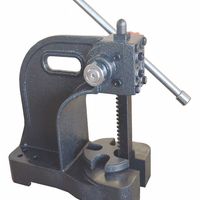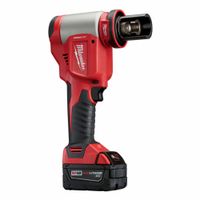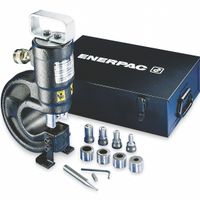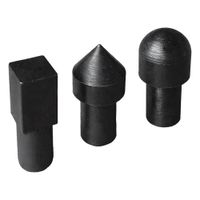Call +(254) 703 030 000 / 751 483 999 / 721 704 777
- Home
- Tools
- Power Tools
- Power Punching Tools
.....Read More
Frequently Asked Questions
What is a power punching tool?
A power punching tool is a mechanical device used to create holes or shapes in various materials such as metal, plastic, or paper. These tools are powered by electricity, hydraulics, or pneumatics, which provide the necessary force to drive a punch through the material. Power punching tools are commonly used in industrial and manufacturing settings for tasks that require precision and efficiency.
There are several types of power punching tools, each designed for specific applications. For instance, a hydraulic punch uses hydraulic pressure to exert force, making it suitable for heavy-duty tasks involving thick or tough materials. Pneumatic punches, on the other hand, use compressed air to deliver force, offering a faster and often more portable solution for lighter materials.
The main components of a power punching tool include the punch, die, and a mechanism to deliver force. The punch is the part that penetrates the material, while the die provides a surface against which the material is pressed, ensuring a clean cut or hole. The mechanism, whether hydraulic, pneumatic, or electric, provides the necessary power to drive the punch through the material.
Power punching tools are valued for their ability to produce consistent and precise results quickly, reducing manual labor and increasing productivity. They are used in various industries, including automotive, aerospace, construction, and metal fabrication, for tasks such as creating holes for fasteners, shaping metal parts, or cutting out intricate designs.
Safety is a critical consideration when using power punching tools, as the high force involved can pose risks to operators. Proper training, maintenance, and the use of safety equipment are essential to ensure safe operation.
How do power punching tools work?
Power punching tools, often referred to as power punches, are mechanical devices used to create holes or shapes in various materials such as metal, plastic, or paper. These tools operate using a combination of mechanical leverage and force, often enhanced by electric, hydraulic, or pneumatic systems, to deliver a powerful and precise punch.
The basic mechanism involves a punch and die setup. The punch is a solid, shaped tool that descends into a corresponding die, which is a cavity or opening that matches the punch's shape. When the punch is driven into the material, it shears or cuts through it, creating a hole or shape that matches the punch and die configuration.
In manual power punches, the user applies force through a lever or handle, which multiplies the force exerted by the user, allowing for efficient punching with minimal effort. In contrast, electric, hydraulic, or pneumatic power punches use motors, hydraulic cylinders, or compressed air to generate the necessary force, enabling them to handle thicker or tougher materials with greater speed and consistency.
These tools are widely used in manufacturing and fabrication industries for tasks such as creating holes for fasteners, producing components with specific shapes, or preparing materials for further processing. The precision and efficiency of power punching tools make them essential for high-volume production environments, where speed and accuracy are critical.
Overall, power punching tools streamline the process of material shaping and hole creation, offering a blend of power, precision, and efficiency that manual methods cannot match.
What materials can power punching tools be used on?
Power punching tools are versatile devices used in various industries for creating holes or indentations in different materials. These tools can be effectively used on:
1. **Metals**: Power punching tools are commonly used on metals such as steel, aluminum, copper, and brass. They are ideal for creating holes in metal sheets, plates, and structural components in manufacturing and construction.
2. **Plastics**: These tools can punch through various types of plastics, including acrylic, polycarbonate, and PVC. They are used in the production of plastic components for electronics, automotive parts, and consumer goods.
3. **Wood**: Power punching tools can be used on wood, particularly in carpentry and furniture making. They help in creating precise holes for dowels, screws, and other fasteners.
4. **Leather**: In the fashion and textile industry, power punching tools are used to punch holes in leather for belts, bags, and other accessories.
5. **Rubber**: These tools can punch holes in rubber materials, which is useful in the production of gaskets, seals, and other rubber components.
6. **Paper and Cardboard**: In the packaging and printing industries, power punching tools are used to create holes or perforations in paper and cardboard for binding, packaging, and decorative purposes.
7. **Composite Materials**: Power punching tools can also be used on composite materials, which are increasingly used in aerospace, automotive, and construction industries.
The choice of tool and technique depends on the material's thickness, hardness, and the precision required for the task.
What are the benefits of using cordless knockout punches?
Cordless knockout punches offer several benefits, particularly in terms of convenience, efficiency, and safety:
1. **Portability**: Being cordless, these tools are highly portable, allowing users to work in various locations without the need for a power outlet. This is especially beneficial in remote or hard-to-reach areas.
2. **Ease of Use**: Cordless knockout punches are generally user-friendly, with intuitive controls that make them accessible even for those with minimal experience. The absence of cords reduces the risk of tripping or tangling, enhancing operational safety.
3. **Time Efficiency**: These tools are designed to quickly and efficiently punch holes in materials like metal, saving significant time compared to manual methods. The speed and precision of cordless knockout punches can lead to increased productivity on job sites.
4. **Versatility**: Many cordless knockout punches come with interchangeable dies and punches, allowing them to be used on various materials and thicknesses. This versatility makes them suitable for a wide range of applications, from electrical work to plumbing.
5. **Reduced Physical Strain**: The ergonomic design of cordless knockout punches minimizes physical strain on the user. They often feature lightweight construction and balanced weight distribution, reducing fatigue during prolonged use.
6. **Battery Technology**: Advances in battery technology have improved the performance and longevity of cordless tools. Modern lithium-ion batteries provide long-lasting power and quick recharge times, ensuring minimal downtime.
7. **Safety Features**: Many models include safety features such as automatic shut-off and overload protection, which help prevent accidents and extend the tool's lifespan.
8. **Clean Work Environment**: Cordless knockout punches produce less noise and debris compared to traditional methods, contributing to a cleaner and quieter work environment.
Overall, cordless knockout punches enhance efficiency, safety, and flexibility in various industrial and construction settings.
How do you maintain a power punching tool?
To maintain a power punching tool, follow these steps:
1. **Regular Cleaning**: After each use, clean the tool to remove dust, debris, and metal shavings. Use a soft brush or compressed air to clean hard-to-reach areas.
2. **Lubrication**: Regularly lubricate moving parts with a suitable oil to reduce friction and prevent rust. Focus on the punch and die areas, as well as any sliding or rotating components.
3. **Inspection**: Frequently inspect the tool for wear and damage. Check the punch and die for sharpness and alignment. Replace any worn or damaged parts immediately to maintain efficiency and safety.
4. **Sharpening**: Keep the punch and die sharp to ensure clean cuts and reduce strain on the tool. Use a sharpening stone or a professional sharpening service as needed.
5. **Alignment**: Ensure the punch and die are properly aligned to prevent uneven wear and damage. Misalignment can lead to poor performance and tool failure.
6. **Storage**: Store the tool in a dry, clean environment to prevent rust and corrosion. Use protective covers or cases to shield it from dust and moisture.
7. **Calibration**: Periodically calibrate the tool to ensure accuracy and precision. Follow the manufacturer's guidelines for calibration procedures.
8. **Follow Manufacturer’s Guidelines**: Adhere to the maintenance schedule and guidelines provided by the manufacturer. This includes using recommended parts and accessories.
9. **Training**: Ensure that operators are properly trained in the use and maintenance of the tool to prevent misuse and extend its lifespan.
10. **Record Keeping**: Maintain a log of maintenance activities, including cleaning, lubrication, inspections, and part replacements, to track the tool’s condition and performance over time.
What safety precautions should be taken when using power punching tools?
When using power punching tools, several safety precautions are essential to prevent accidents and ensure safe operation:
1. **Personal Protective Equipment (PPE):** Always wear appropriate PPE, including safety goggles to protect eyes from flying debris, ear protection to guard against noise, gloves to prevent hand injuries, and steel-toed boots to protect feet.
2. **Training and Familiarization:** Ensure that operators are adequately trained and familiar with the tool's operation, including understanding the user manual and safety instructions.
3. **Inspection and Maintenance:** Regularly inspect the tool for any signs of damage or wear. Ensure all parts are functioning correctly and perform routine maintenance as recommended by the manufacturer.
4. **Work Area Safety:** Keep the work area clean and free of clutter. Ensure adequate lighting and ventilation. Remove any tripping hazards and ensure that the floor is dry to prevent slips.
5. **Secure Workpiece:** Ensure that the material being punched is securely clamped or held in place to prevent movement during operation.
6. **Correct Tool Usage:** Use the tool only for its intended purpose and within its specified capacity. Avoid using excessive force or applying the tool at awkward angles.
7. **Power Source Safety:** Ensure that the power source is appropriate for the tool. Check electrical cords for damage and avoid using extension cords if possible. Disconnect the tool from the power source when not in use or when changing accessories.
8. **Emergency Procedures:** Be aware of emergency shut-off procedures and ensure that first aid kits and fire extinguishers are accessible.
9. **Avoid Distractions:** Stay focused on the task at hand and avoid distractions. Do not operate the tool if fatigued or under the influence of substances.
10. **Proper Storage:** Store the tool in a safe, dry place when not in use, away from unauthorized users, especially children.
How do you choose the right size punch and die for a specific job?
To choose the right size punch and die for a specific job, consider the following factors:
1. **Material Type and Thickness**: Determine the material you are working with and its thickness. Different materials require different punch and die clearances. For example, softer materials like aluminum need less clearance than harder materials like stainless steel.
2. **Clearance**: Calculate the clearance between the punch and die. This is typically a percentage of the material thickness. For most materials, a clearance of 10-20% of the material thickness is standard, but this can vary based on the material and the precision required.
3. **Punch and Die Size**: The punch size is usually the size of the hole you want to create. The die size will be slightly larger to accommodate the clearance. Ensure the punch and die are compatible with the press machine being used.
4. **Tooling Strength**: Ensure the punch and die can withstand the force required to cut through the material. This involves considering the tonnage capacity of the press and the strength of the tooling material.
5. **Shape and Design**: Consider the shape and design of the punch and die. Complex shapes may require custom tooling. Ensure the design allows for efficient material flow and minimizes wear.
6. **Machine Compatibility**: Verify that the punch and die are compatible with the machine in terms of size, shape, and mounting requirements.
7. **Quality and Precision Requirements**: Higher precision jobs may require tighter tolerances and higher quality tooling to achieve the desired results.
8. **Cost and Availability**: Consider the cost of the punch and die and their availability. Custom or specialized tooling may be more expensive and have longer lead times.
By evaluating these factors, you can select the appropriate punch and die size for your specific job, ensuring efficiency and quality in the punching process.



